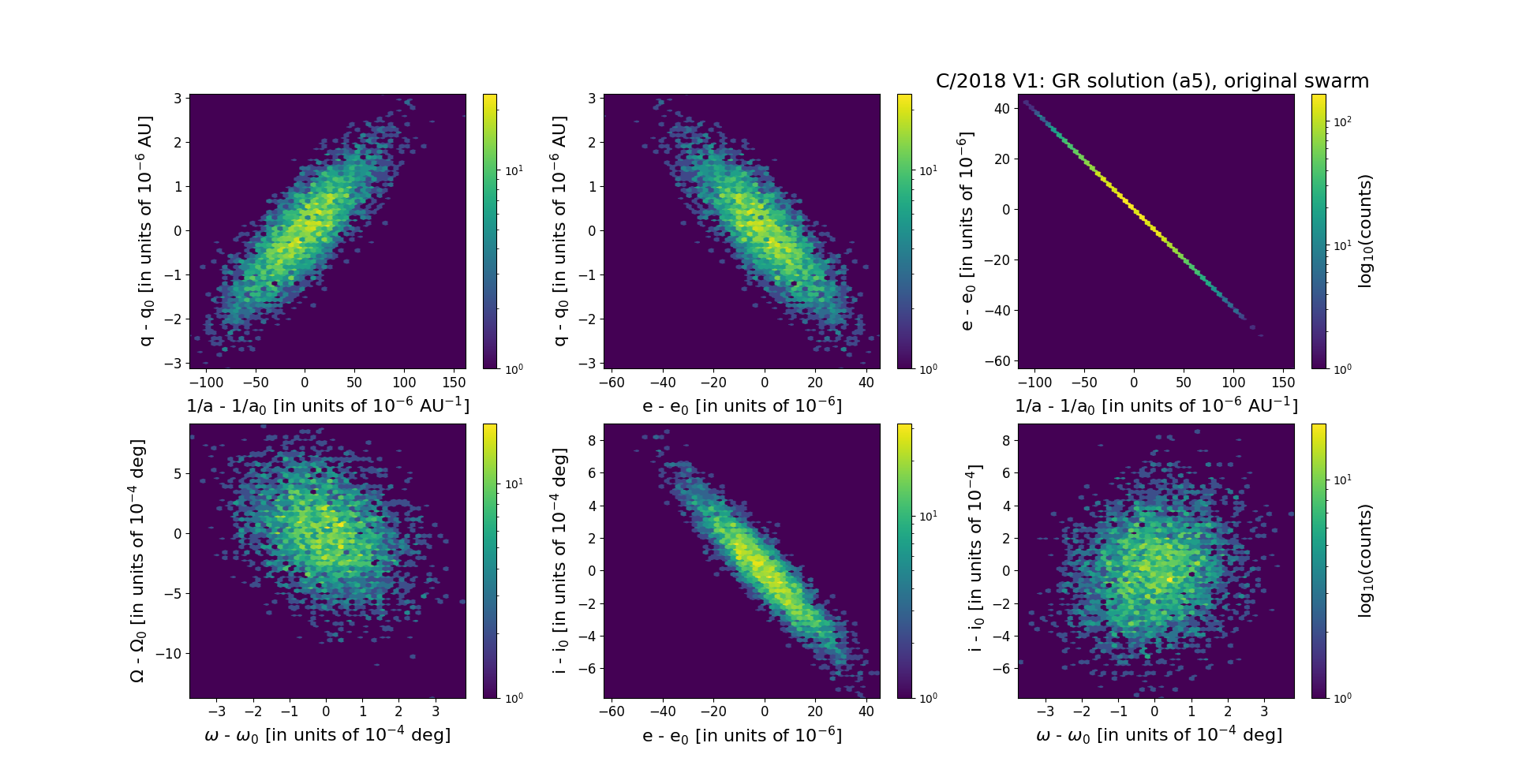C/2018 V1 Machholz-Fujikawa-Iwamoto
more info
Comet C/2018 V1 was discovered on 7 November 2019, about one months before its perihelion passage, and was last seen on 15 December 2018.
Solutions (GR and NG) given here span over 0.101 yr in a range of heliocentric distances: 0.75 au – 0.39 au (perihelion) – 0.50 au;due to short data arc the orbital parameters are uncertain (orbit of 2b quality class).
This comet suffers notable planetary perturbations during its passage through the planetary system; in both cases (GR and NG model of motion) these perturbations lead to escape the comet from the planetary zone on a hyperbolic orbit (see future barycentric orbits).However, the original orbits in both solutions differ and the interstellar origin of this comet cannot be ruled out.
Solutions (GR and NG) given here span over 0.101 yr in a range of heliocentric distances: 0.75 au – 0.39 au (perihelion) – 0.50 au;due to short data arc the orbital parameters are uncertain (orbit of 2b quality class).
This comet suffers notable planetary perturbations during its passage through the planetary system; in both cases (GR and NG model of motion) these perturbations lead to escape the comet from the planetary zone on a hyperbolic orbit (see future barycentric orbits).However, the original orbits in both solutions differ and the interstellar origin of this comet cannot be ruled out.
| solution description | ||
|---|---|---|
| number of observations | 766 | |
| data interval | 2018 11 08 – 2018 12 15 | |
| data type | perihelion within the observation arc (FULL) | |
| data arc selection | entire data set (STD) | |
| range of heliocentric distances | 0.75 au – 0.39 au (perihelion) – 0.5 au | |
| detectability of NG effects in the comet's motion | comet with determinable NG~orbit | |
| type of model of motion | GR - gravitational orbit | |
| data weighting | YES | |
| number of residuals | 1518 | |
| RMS [arcseconds] | 0.56 | |
| orbit quality class | 2b | |
| orbital elements (barycentric ecliptic J2000) | ||
|---|---|---|
| Epoch | 1726 09 10 | |
| perihelion date | 2018 12 03.48151735 | ± 0.00003228 |
| perihelion distance [au] | 0.38989319 | ± 0.00000093 |
| eccentricity | 1.00017532 | ± 0.00001413 |
| argument of perihelion [°] | 88.349982 | ± 0.000105 |
| ascending node [°] | 128.263027 | ± 0.000300 |
| inclination [°] | 144.076718 | ± 0.000241 |
| reciprocal semi-major axis [10-6 au-1] | -449.66 | ± 36.25 |
| file containing 5001 VCs swarm |
|---|
| 2018v1a5.bmi |

Upper panel: Time distribution of positional observations with corresponding heliocentric (red curve) and geocentric (green curve) distance at which they were taken. The horizontal dotted line shows the perihelion distance for a given comet whereas vertical dotted line — the moment of perihelion passage.
Middle panel(s): O-C diagram for a given solution (sometimes in comparison to another solution available in CODE), where residuals in right ascension are shown using magenta dots and in declination by blue open circles.
Lowest panel: Relative weights for a given data set(s).
Middle panel(s): O-C diagram for a given solution (sometimes in comparison to another solution available in CODE), where residuals in right ascension are shown using magenta dots and in declination by blue open circles.
Lowest panel: Relative weights for a given data set(s).
